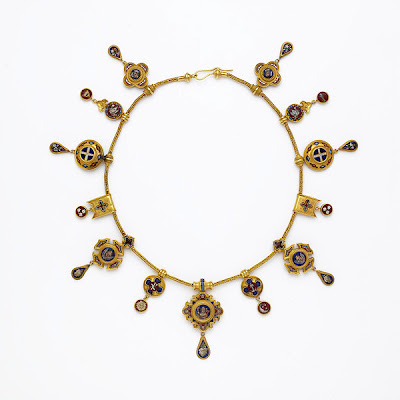Mounted on a piece of wood, this fragment of embroidery was once framed behind glass for display at the Great Exhibition of 1851 where it was described as “a design for trimming or ornament.” While embroidery like this would have been used to adorn a garment or for trimming decorative home items, such a fine piece of needlework would probably have been displayed on a wall,like a painting.
The embroiderer, C. Georgiana Mowland (1834-?) has taken extreme care to show the plants in great detail, suggesting that she may have been inspired by the botanical prints that were popular at the time—especially those of the painter Pierre-Joseph Redouté (1759-1840) who was best known for his illustrations of roses.
C. Georgiana Mowland was a London schoolgirl who lived near to the current home of the Victoria & Albert Museum. They resided in a garage flat above the mews in Belgravia’s posh Eaton Square. The eldest child of Matthew Mowland, a coach driver, and his wife Eliza, Georgiana spent her time, like other girls her age, engaged in embroidery. However, unlike other amateur embroiderers, she shows exquisite skill and fineness of hand.
This fragment of her art is worked on an oblong piece of white satin, and shows a mixture of flat embroidery and raised appliqué techniques. A central spray of white Bourbon roses depicts one full-blown flower worked in white crepe fabric with stems stitched in green and brown silk threads. Assorted foliage is worked in lengths of wired chenille in shades of green and brown with and the buds in écru wired chenille.
An additional spray of flowers graces each corner. The upper pair of sprays shows blossoms with five rounded petals of white crepe fabric and stems worked in green and yellow silks. The lower pair are similar but the blossoms demonstrate pointed petals made of cream crepe fabric.
In 1851, Mowland entered this work in the Great Exhibition. The Exhibition, as were Prince Albert’s wishes, included work by children and for children. Miss Mowland’s entry is an unusual piece since, at this time, children were more encouraged to focus on plain sewing techniques for practical use. Clearly, this entry would have been an exquisite surprise. The text stitched into the accompanying canvas is set within a border of stylized laurel leaves worked in tent stitch using red silks. A cross in red at each corner accompanies a split line of stylized bay leaves in green to fill out the last line of text.
The following text accompanied the embroidery, worked on canvas in embroidery by Miss Mowland for her entry in the Exhibition:
A Specimen of Raised Embroidery
Executed by C G Mowland No 23
Eaton Mews South Eaton Sq Aged 12
Class 19 No 228 Tapestry in the
Exhibition 1851 Design for trimming
or ornament
Crape Embroidery
on satin ground.
No. 454a.
(in Register)
We know little else about C. Georgiana Mowland except that records indicate that the “C” most likely stood for “Charlotte,” and that she was later married to a George Pewsey (a watch and clock maker).




























